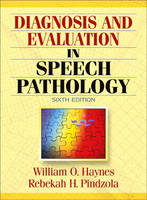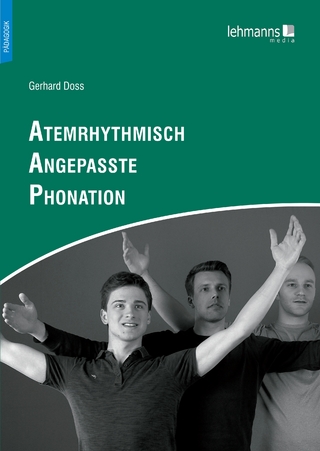
Diagnosis and Evaluation in Speech Pathology
Pearson (Verlag)
978-0-205-38669-7 (ISBN)
- Titel erscheint in neuer Auflage
- Artikel merken
The Sixth Edition of Diagnosis and Evaluation in Speech Pathology continues to be the leading text in its field, providing a practical process approach to diagnosing and evaluating speech and language disorders.
This easy-to-read, yet comprehensive resource provides a strong foundation of diagnosis and evaluation for students in training and clinicians alike. It develops a rationale for each type of assessment, including both standardized and non-standardized approaches. This text is ideal for practitioners and clinicians who are struggling to stay in tune with the rapidly changing field of Speech Language Pathology.
All chapters conclude with “Bibliography.”
1. Introduction to Diagnosis and Evaluation: Philosophical Issues and General Guidelines.
Diagnosis and Evaluation Defined.
Diagnosis to Determine the Reality of the Problem.
Diagnosis to Determine the Etiology of the Problem.
Diagnosis to Provide Clinical Focus.
Diagnosis: Science and Art.
Diagnosis Versus Eligibility.
The Diagnostician as a Factor.
The Client-Clinician Relationship.
The Client as a Factor: Children, Adolescents, and Adults.
Putting the Diagnosis to Work.
Precepts Regarding the Clinical Examination.
2. Interviewing.
The Importance of Interviewing.
The Nature of Interviewing.
Common Interviewing Considerations.
An Approach to Interviewing.
Improving Interviewing Skills.
3. Psychometric Considerations in Diagnosis and Evaluation.
Common Types of Tests.
Validity: The Foundation of the Test or Measure.
Reliability.
Some Quantitative Background for the Test Interpretation.
Central Tendency, Variance, and the Normal Curve.
Criteria for Evaluating Standardized Tests.
Common Errors in the Use of Norm-Referenced Tests.
Conclusion.
4. Assessment of Children with Limited Language.
The Process of Becoming a Communicator: Getting the "Big Picture."
Focusing on the Child's Language Level: Nonverbal, Single Word and Multiword Communicators.
Considering "Etiology."
Why Is Early Language Assessment So Difficult?
Models to Consider in Language Assessment.
Theoretical Considerations in Language Assessment.
Preassessment and Pertinent Historical Information.
Assessment of Social Prerequisites and Caretaker/Child Interaction.
Adaptive Behavior Scales.
Assessment of Cognitive Attainments Associated with Communication.
Assessment of Communicative Intent and Function.
Use of Tests and Formal Procedures with Limited Language Children.
Assessment of Structure and Function in Early Utterances.
Assessment of Children's Early Language Comprehension.
Assessment of Utterances Using Length Measures.
Infant, Toddler and Family Assessment.
Assessment of Special Populations.
Consolidating Data and Arriving at Treatment Recommendations.
Concluding Remarks.
5. Assessment of School-Age and Adolescent Language Disorders.
Students with Language Problems: The "High Risk" Groups.
Use of Standardized Tests with Syntax Level Children.
Language Sampling: A General Look at the Process.
Later Language Development: Emerging Data.
Testing Language Comprehension.
Assessment of Syntax Using Packages.
Assessment of Conversational Pragmatics.
Evaluation of Metalinguistic Ability and School Curriculum.
Conclusion.
6. Assessment of Phonological Disorders.
Multiple Components Contributing to Sound Production.
Seven Important Knowledge Areas for Evaluation of Articulation and Phonological Disorders.
Screening for Phonological Disorders.
Traditional Assessment Procedures.
Test Procedures that Evaluate Phonetic Context Effects.
The Phonetic and Phonemic Inventories.
Distinctive Feature Analysis.
Phonological Analysis.
Other Testing.
Integrating Data from Assessment.
Severity and Intelligibility.
Computer-Assisted Analysis of Phonology.
Long Term Impact of Phonological Disorders.
7. Disorders of Fluency.
Differential Diagnosis.
The Appraisal of Stuttering.
Evaluation at the Onset of Stuttering.
Evaluation of the School-Aged Student
Assessment of the Adult Who Stutters.
8. Assessment of Aphasia.
The Nature of Aphasia.
Case History.
Diagnosis and Formal Testing.
Differential Diagnosis.
The Art of Informal Assessment.
Summing Up the Findings.
9. Motor Speech Disorders, Dysphagia, and the Oral Exam.
Apraxia of Speech in Adults.
Developmental Apraxia of Speech.
The Adult Dysarthrias.
Cerebral Palsies and Dysarthria in Children.
The Oral Peripheral Examination.
Dysphagia.
10. Laryngeal Voice Disorders.
The Nature of Vocal Disturbances.
The Presenting Complaint and Case History Intake.
Informal Evaluation: A Listening and Rating Process.
Objective and Sophisticated Measures.
Informal Assessment Probes.
Prognosis.
Assessment of the Laryngectomee.
Conclusion.
11. Assessment of Resonance Imbalance.
Categories of Abnormal Resonance.
Case History and General Voice Assessment.
Assessment Techniques and Probes for Resonance Imbalance.
Assessment Associated with Cleft Palate.
Prognosis Associated with Resonance Imbalance.
Conclusion.
12. Multicultural Issues in Assessment.
Population and Professional Trends.
Cultural Differences in Perceptions of Disability.
Interviewing and Counseling Issues.
Cultural Differences in Incidence/Prevalence of Communication Disorders.
Language Assessment: The Most Problematic Area.
Contrastive Analysis.
Minimal Competency Core.
Processing Tasks.
Dynamic Assessment.
Specific Examples from African-American English and Hispanic English.
13. The Diagnostic Report.
Format.
Confidentiality.
Style.
The Writing Process.
Follow-Up.
Appendix A. Coding Sheet for Early Multiword Analysis.
Appendix B. Summary Sheet for Early Multiword Analysis.
| Erscheint lt. Verlag | 5.12.2003 |
|---|---|
| Sprache | englisch |
| Maße | 178 x 235 mm |
| Gewicht | 866 g |
| Themenwelt | Geisteswissenschaften ► Sprach- / Literaturwissenschaft ► Sprachwissenschaft |
| ISBN-10 | 0-205-38669-5 / 0205386695 |
| ISBN-13 | 978-0-205-38669-7 / 9780205386697 |
| Zustand | Neuware |
| Haben Sie eine Frage zum Produkt? |
aus dem Bereich


